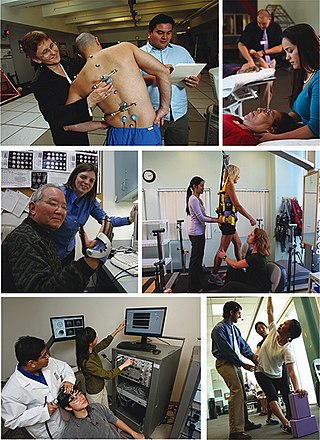Related Research Articles
Hemiparesis, or unilateral paresis, is weakness of one entire side of the body. Hemiplegia is, in its most severe form, complete paralysis of half of the body. Hemiparesis and hemiplegia can be caused by different medical conditions, including congenital causes, trauma, tumors, or stroke.
Occupational therapists (OTs) are health care professionals specializing in occupational therapy and occupational science. OTs and occupational therapy assistants (OTAs) use scientific bases and a holistic perspective to promote a person's ability to fulfill their daily routines and roles. OTs have training in the physical, psychological, and social aspects of human functioning deriving from an education grounded in anatomical and physiological concepts, and psychological perspectives. They enable individuals across the lifespan by optimizing their abilities to perform activities that are meaningful to them ("occupations"). Human occupations include activities of daily living, work/vocation, play, education, leisure, rest and sleep, and social participation.
Activities of daily living (ADLs) is a term used in healthcare to refer to people's daily self-care activities. Health professionals often use a person's ability or inability to perform ADLs as a measurement of their functional status. The concept of ADLs was originally proposed in the 1950s by Sidney Katz and his team at the Benjamin Rose Hospital in Cleveland, Ohio. Since then, a number of researchers have improved and added to the concept of ADLs. For example, many indexes that assess ADLs now include some measure of mobility.

Geriatrics, or geriatric medicine, is a medical specialty focused on providing care for the unique health needs of the elderly. The term geriatrics originates from the Greek γέρων geron meaning "old man", and ιατρός iatros meaning "healer". It aims to promote health by preventing, diagnosing and treating disease in older adults. There is no defined age at which patients may be under the care of a geriatrician, or geriatric physician, a physician who specializes in the care of older people. Rather, this decision is guided by individual patient need and the caregiving structures available to them. This care may benefit those who are managing multiple chronic conditions or experiencing significant age-related complications that threaten quality of daily life. Geriatric care may be indicated if caregiving responsibilities become increasingly stressful or medically complex for family and caregivers to manage independently.

A spirometer is an apparatus for measuring the volume of air inspired and expired by the lungs. A spirometer measures ventilation, the movement of air into and out of the lungs. The spirogram will identify two different types of abnormal ventilation patterns, obstructive and restrictive. There are various types of spirometers that use a number of different methods for measurement.

Kinesiology is the scientific study of human body movement. Kinesiology addresses physiological, anatomical, biomechanical, pathological, neuropsychological principles and mechanisms of movement. Applications of kinesiology to human health include biomechanics and orthopedics; strength and conditioning; sport psychology; motor control; skill acquisition and motor learning; methods of rehabilitation, such as physical and occupational therapy; and sport and exercise physiology. Studies of human and animal motion include measures from motion tracking systems, electrophysiology of muscle and brain activity, various methods for monitoring physiological function, and other behavioral and cognitive research techniques.

In haemodynamics, the body must respond to physical activities, external temperature, and other factors by homeostatically adjusting its blood flow to deliver nutrients such as oxygen and glucose to stressed tissues and allow them to function. Haemodynamic response (HR) allows the rapid delivery of blood to active neuronal tissues. The brain consumes large amounts of energy but does not have a reservoir of stored energy substrates. Since higher processes in the brain occur almost constantly, cerebral blood flow is essential for the maintenance of neurons, astrocytes, and other cells of the brain. This coupling between neuronal activity and blood flow is also referred to as neurovascular coupling.
The metabolic equivalent of task (MET) is the objective measure of the ratio of the rate at which a person expends energy, relative to the mass of that person, while performing some specific physical activity compared to a reference, currently set by convention at an absolute 3.5 mL of oxygen per kg per minute, which is the energy expended when sitting quietly by a reference individual, chosen to be roughly representative of the general population, and thereby suited to epidemiological surveys. A Compendium of Physical Activities is available online, which provides MET values for hundreds of activities.
Cardiorespiratory fitness (CRF) refers to the ability of the circulatory and respiratory systems to supply oxygen to skeletal muscles during sustained physical activity. Scientists and researchers use CRF to assess the functional capacity of the respiratory and cardiovascular systems. These functions include ventilation, perfusion, gas exchange, vasodilation, and delivery of oxygen to the body's tissues. As these body's functions are vital to an individual's health, CRF allows observers to quantify an individual's morbidity and mortality risk as a function of cardiorespiratory health.

Blunt trauma, also known as blunt force trauma or non-penetrating trauma, describes a physical trauma due to a forceful impact without penetration of the body's surface. Blunt trauma stands in contrast with penetrating trauma, which occurs when an object pierces the skin, enters body tissue, and creates an open wound. Blunt trauma occurs due to direct physical trauma or impactful force to a body part. Such incidents often occur with road traffic collisions, assaults, sports-related injuries, and are notably common among the elderly who experience falls.
Disability Determination Services, commonly called DDS, are state agencies that are funded by the US federal government. Their purpose is to make disability findings for the Social Security Administration.
The Kurtzke Expanded Disability Status Scale (EDSS) is a method of quantifying disability in multiple sclerosis. The scale has been developed by John F. Kurtzke. The EDSS is based on a neurological examination by a clinician. However, a number of versions have been developed which enable patient self-administration.
The Defense Base Act (DBA) is an extension of the federal workers' compensation program that covers longshoremen and harbor workers, the Longshore and Harbor Workers' Compensation Act 33 U.S.C. §§ 901–950. The DBA covers persons employed at United States defense bases overseas. The DBA is designed to provide medical treatment and compensation to employees of defense contractors injured in the scope and course of employment. The DBA is administered by the United States Department of Labor.

Pulmonary function testing (PFT) is a complete evaluation of the respiratory system including patient history, physical examinations, and tests of pulmonary function. The primary purpose of pulmonary function testing is to identify the severity of pulmonary impairment. Pulmonary function testing has diagnostic and therapeutic roles and helps clinicians answer some general questions about patients with lung disease. PFTs are normally performed by a pulmonary function technician, respiratory therapist, respiratory physiologist, physiotherapist, pulmonologist, or general practitioner.
Workplace health surveillance or occupational health surveillance (U.S.) is the ongoing systematic collection, analysis, and dissemination of exposure and health data on groups of workers. The Joint ILO/WHO Committee on Occupational Health at its 12th Session in 1995 defined an occupational health surveillance system as "a system which includes a functional capacity for data collection, analysis and dissemination linked to occupational health programmes".
The Barthel scale is an ordinal scale used to measure performance in activities of daily living (ADL). Each performance item is rated on this scale with a given number of points assigned to each level or ranking. It uses ten variables describing ADL and mobility. A higher number is associated with a greater likelihood of being able to live at home with a degree of independence following discharge from hospital. The amount of time and physical assistance required to perform each item are used in determining the assigned value of each item. External factors within the environment affect the score of each item. If adaptations outside the standard home environment are met during assessment, the participant's score will be lower if these conditions are not available. If adaptations to the environment are made, they should be described in detail and attached to the Barthel index.

Vocational rehabilitation, also abbreviated VR or voc rehab, is a process which enables persons with functional, psychological, developmental, cognitive, and emotional disabilities, impairments or health disabilities to overcome barriers to accessing, maintaining, or returning to employment or other useful occupations.

4-point player is a disability sport classification for wheelchair basketball. Players in this class have normal trunk function but have a reduced level of functioning in one or both of their lower limbs. They may have difficulty with sideways movements. People in this class include ISOD classified A1, A2 and A3 players.
The Disability Rating Scale (DRS) was developed as a way to track a traumatic brain injury (TBI) patient from 'Coma to Community'. The scale was used to rate the effects of injury and decide how long recovery might take. The rating gives insight into the cognitive impairment of the individual with the TBI.
Age-related mobility disability is a self-reported inability to walk due to impairments, limited mobility, dexterity or stamina. It has been found mostly in older adults with decreased strength in lower extremities.
References
- ↑ Wind, Haje (October 2009). "Effect of Functional Capacity Evaluation information on the judgment of physicians about physical work ability in the context of disability claims". Int Arch Occup Environ Health. 82 (9): 1087–96. doi:10.1007/s00420-009-0423-8. PMC 2746897 . PMID 19458959.
- 1 2 Irmo Marini, Mark Stebnicki, ed. (2008). The Professional Counselor's Desk Reference. Springer Publishing Company. p. 519. ISBN 9780826115478.
- ↑ Chen, M.D., Joseph J. (2007). "Functional Capacity Evaluation and Disability". The Iowa Orthopaedic Journal. 27: 121–127. PMC 2150654 . PMID 17907444.
- ↑ "FCE Fairfax VA, Woodbridge VA, Silver Spring MD". www.dynamicrehabtherapy.com. Retrieved 2016-04-04.
- 1 2 Whinney, Christopher M. "Perioperative Evaluation". Cleveland Clinic. Retrieved 2014-01-29.
- ↑ Jetté, M.; Sidney, K.; Blümchen, G. (August 1990). "Metabolic Equivalents (METS) in Exercise Testing, Exercise Prescription, and Evaluation of Functional Capacity". Clinical Cardiology. 13 (8): 555–565. doi:10.1002/clc.4960130809. PMID 2204507.